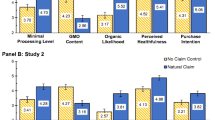Abstract
Consumers rely on nutrition ingredient names in their food evaluations. Food companies could announce an ingredient name by using its common name focusing on the effects of a food component familiar to consumers (i.e., the name of the compound) or its specific and academia-based name (i.e., scientific name). Ares et al. (2009) indicated that displaying ingredient name affected consumer’s food evaluation. Drawing from construal level theory (Trope et al. 2007), we propose that consumers will look for advertising cues, which are congruent with high or low construal level that will facilitate or eliminate the effectiveness of ingredient name. Two moderators are proposed: food types (vice vs. virtue) and regulatory foci (promotion vs. prevention).
Two experiments show that a common name works better than a scientific name when vice food is promoted with promotion focus. On the other hand, a scientific name is more persuasive when virtue food is presented with prevention focus. The choice of ingredient name does not matter when vice food with prevention focus or food virtue with promotion focus is promoted. This research further demonstrates that perceived guilt and perceived efficacy respectively serve as the underlying mechanism for vice and virtue foods.
The current research makes theoretical contributions. First, it expands the knowledge and usage of food label in choosing the compatible ingredient name. The right combinations lead to higher product evaluations. Second, construal level theory explains how the different psychological construals will influence the effects of ingredient names. The results support the notion that a common (scientific) name is associated with high (low) construal level. Finally, the underlying mechanisms of perceived guilt and perceived efficacy enhance the knowledge and understanding behind the interaction effect.
The usage of presenting ingredient name offers important implications for both brand managers and marketers. First, marketers should consider how to eliminate the weakness of the product attributes and strengthen the benefits. Second, marketers should try to lower the perceived guilt of consumers vice consumption and increase the perceived efficacy of the virtue food by varying ingredient name and regulatory focus. Finally, vice and virtue are not always bipolar. Advertisers are able to frame their product in more vice or virtue by focusing hedonic attributes (e.g., taste or eating enjoyment) or utilitarian attributes (e.g., health goal or freshness).
Access this chapter
Tax calculation will be finalised at checkout
Purchases are for personal use only
Similar content being viewed by others
Author information
Authors and Affiliations
Corresponding author
Editor information
Editors and Affiliations
Rights and permissions
Copyright information
© 2020 The Academy of Marketing Science
About this paper
Cite this paper
Tok, D., Chang, CT. (2020). How Common or Scientific Name Works? The Influence of Food Type and Regulatory Focus on the Choice of Ingredient Name: An Abstract. In: Wu, S., Pantoja, F., Krey, N. (eds) Marketing Opportunities and Challenges in a Changing Global Marketplace. AMSAC 2019. Developments in Marketing Science: Proceedings of the Academy of Marketing Science. Springer, Cham. https://doi.org/10.1007/978-3-030-39165-2_225
Download citation
DOI: https://doi.org/10.1007/978-3-030-39165-2_225
Published:
Publisher Name: Springer, Cham
Print ISBN: 978-3-030-39164-5
Online ISBN: 978-3-030-39165-2
eBook Packages: Business and ManagementBusiness and Management (R0)




